Miniature Golf Course Business Plan
Sammy’s is a Family Entertainment Center with a natural-looking miniature golf course as the initial anchor for other attractions. Family Entertainment is a highly profitable industry that has been rapidly growing due to a trend within the country to return to family values. The initial profit centers will be the miniature golf course, video arcade, climbing wall, and food service.
Marketing
There are 150,000 people living within a 15-mile radius of the Firefly County site. The miniature golf business has a broad customer base including families with children, seniors, teens, and corporate customers. Fun promotions keep the business profitable throughout the season. Our marketing plan is based on successful plans in the industry, with some additions. Mulligan-Bogey Leisure Builders include a marketing plan with golf course completion, involving input from over 200 course owners and successful marketing programs across the country.
Management
John and Michelle Putteer have experience in small business ownership, personnel management, and financial management. The miniature golf course operates with minimal staff. This keeps management easy and employee costs low.
Financial
The low inventory and operational costs of a miniature golf course allow for early profits. With conservatively planned first-year sales projections, this business should be profitable from year one.
Investment Objectives
Sammy’s will become operational with an initial investment from owners John and Michelle Putteer and a long-term loan. One local commercial lender has shown interest in the business concept. Local investors have also expressed interest in investing in the project.
1.1 Keys to Success
A highly visible, well-trafficked site near the center of our service area.
1.2 Objectives
The main objective of Sammy’s is to provide a safe, relaxing setting for family and friends to enjoy quality time together while participating in fun and exciting outdoor activities.
– Open for business on April 15.
– Be profitable in the first year.
– First-year sales above par.
– Add a Go-Kart track after three years of operation.
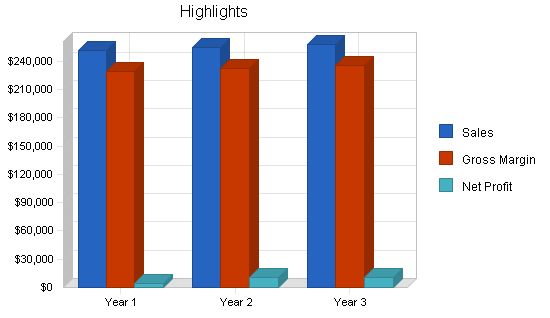
The mission of Sammy’s is to provide a fun, affordable, family entertainment center for community members in and around Firefly County.
Sammy’s is a Family Entertainment Center with a world-class, natural-looking miniature golf course as the initial anchor for other attractions. Sammy’s hallmark will be a large, natural-looking waterfall and water features. Family Entertainment is a highly profitable industry that has been rapidly growing due to a trend of returning to family values. The initial profit centers will be a miniature golf course, video arcade, climbing wall, and food service.
Miniature golf is NOT golf in miniature. However, it does have a lot in common with regulation golf. Miniature golf holes must have contour changes like a regulation green to be interesting. Undulations and banking add challenge and fun to the game.
The anchor of Sammy’s is a “new concept” miniature golf course, also known as a “sports course.” Modern miniature golf courses are designed with attractive landscaping, water features, and elevation changes. The focal point of Sammy’s course design will be a waterfall, which defines the course both visually and audibly.
The golf course is being designed and built by Mulligan-Bogey Leisure Builders, Inc., the most respected miniature golf course company in the United States. Mulligan-Bogey has built over 400 profitable courses in their 40 years of business, demonstrating their knowledge in creating successful facilities. The course will be challenging but not overly so, encouraging customers to return and improve their scores.
The start-up costs include construction, equipment, initial expenses, and working capital. Short-term assets such as office furniture and kitchen equipment are required, and initial cash is needed to cover the first month of operations. The owners are making a cash investment, and additional loan financing is being arranged for ramp up and launch.
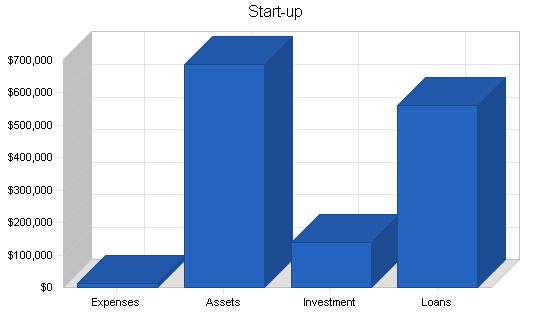
Start-up
Requirements
Start-up Expenses
Legal $1,250
Brochures $1,000
Insurance $7,500
Rent $1
Start-up Food costs $500
Supplies and Disposables $3,250
Total Start-up Expenses $13,501
Start-up Assets
Cash Required $13,769
Other Current Assets $23,230
Long-term Assets $649,500
Total Assets $686,499
Total Requirements $700,000
Start-up Funding
Start-up Expenses to Fund $13,501
Start-up Assets to Fund $686,499
Total Funding Required $700,000
Assets
Non-cash Assets from Start-up $672,730
Cash Requirements from Start-up $13,769
Additional Cash Raised $0
Cash Balance on Starting Date $13,769
Total Assets $686,499
Liabilities and Capital
Liabilities
Current Borrowing $0
Long-term Liabilities $560,000
Accounts Payable (Outstanding Bills) $0
Other Current Liabilities (interest-free) $0
Total Liabilities $560,000
Capital
Planned Investment
Owners Equity Investment $140,000
Other $0
Additional Investment Requirement $0
Total Planned Investment $140,000
Loss at Start-up (Start-up Expenses) ($13,501)
Total Capital $126,499
Total Capital and Liabilities $686,499
Total Funding $700,000
2.2 Company Ownership
Sammy’s will be created as a privately owned Subchapter C Corporation, registered in Firefly County. Stock will be equally held by the principal investors John and Michelle Putteer. As of this writing, the corporation has not been chartered. Other options of legal formation are still being investigated.
Products and Services
Miniature Golf
The primary attraction is the world class 18-hole miniature golf course, where participants have fun for only $5 per round. The challenge in miniature golf is to make the course interesting to play. Interesting shots bring repeat business. Undulations, banking, green size, cup position, mixing easier and more difficult holes, and other refinements come from experience and determine success.
On a well-designed course, a player is rewarded for a good putt without being overly penalized for a poor putt. If you hit the putt correctly it will go in the cup. If you hit it poorly it may take two or three putts, but you are not “out of play” or holding up the group behind you.
Players take about one hour to complete a round of golf. The course can accommodate up to 100 players per hour during peak times. These numbers are common on weekend evenings during the summer.
Rock Climbing Wall
The 24-foot portable rock-climbing wall offers adventure for those interested in extreme sports. The wall is usually located on site, but can be set up at fairs/festivals, school parking lots, or company picnics.
The climbing wall is mounted on a double axle trailer. The wall is raised and lowered by the trailer hydraulics in a few minutes. Complete set-up takes only ten minutes. There are three climbing stations with state of the art auto belay systems, allowing everyone to climb without fear of injury.
Video Arcade
The video arcade has popular games for children of all ages. The games vary in type and skill level. Some are physically oriented; others focus on hand-eye coordination. The most profitable games issue tickets that may be redeemed for prizes. The arcade will be operated on a 50-50 split with a regional arcade company. Coin-operated games, both redemption/skill and video, are the second top attraction and revenue source, behind birthday parties.
Food Service
A small snack bar will serve fountain drinks, hot dogs, chips, and frozen custard (ice cream). The food area will also provide space for birthdays and other private parties. A renter may use our food fare or use our outside caterer.
Customers will walk through the food service area to and from the miniature golf course. As the customers walk off the 18th hole they find hot dogs, chips, and fountain drinks awaiting them. Frozen custard is a summer favorite too. The food service is a profitable part of the business.
Vending
In addition to the arcade, there are two other profit centers using vending machines. On the course, a bottled water vending machine is located between the 9th and 10th hole. There are also three fish food vending machines located at the Koi ponds, which are part of the golf experience. Other course operators are redeeming $13,000 per year from their fish food vending machines.
On a national level, the top revenue generators at FEC’s are motion simulators (arcade), birthday and other parties, miniature golf, food and beverage, and go-karts.
3.1 Future Growth
Sammy’s plans to expand and add additional products and services in the future. Some of the options being considered include:
– Go-Karts
– Second 18 holes of miniature golf
– Trampoline Thing
– Logo sportswear sales
– Remote control 4WD vehicles
– Lagoon for bumper boats and/or remote control boats.
Market Analysis Summary
There are over 150,000 people living within a 15-mile radius of the Firefly County site. The customer base for miniature golf is broad, including families with children, teenagers, seniors, and corporate customers. Successful marketing programs from other course owners in the industry will be incorporated, with some additions.
Customers will appreciate Sammy’s high value-to-cost ratio. The facility, friendly staff, and variety of entertainment make it the first choice for individual, family, or group entertainment.
4.1 Market Segmentation
Sammy’s target audience includes:
– Individuals: Over 150,000 people living within 15 miles of the location in Firefly County, ranging in age from six to fifty-four, with family income over $20,900.
– Families with young children.
– Teens and young adults, age 15 to 24.
– Adults, age 25 to 54.
– Seniors, age 55 to 74.
– Private groups, including children’s birthday parties, family get-togethers, and organizations such as church groups, civic organizations, and corporate parties.
Sammy’s aims to understand and satisfy customers’ needs through a three-fold business goal: getting the customer in the door, keeping them entertained, and getting them to come back.
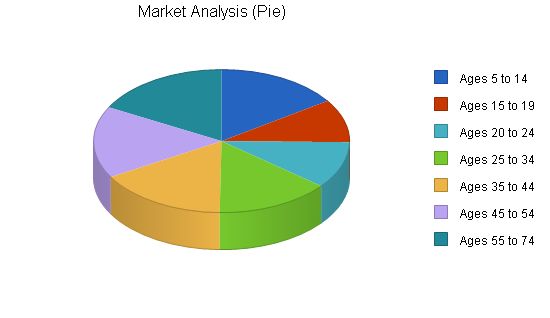
Market Analysis
Market Analysis
The Family Entertainment Industry has experienced significant growth in the past decade. Research has been conducted to aid in the industry’s further development. The markets listed below are proven segments for FECs to target in their marketing efforts.
A. Individuals
Families with young children enjoy outings. Miniature golf is a popular activity for teenagers to do with their parents. Research shows that children 5 to 18 years old, with at least one adult, represent the largest market segment (36.9%) attending FECs.
Teens and young adults enjoy making outings a date. FECs have proven popular with college age students, especially those attending Southeast State University and Firefly Community College.
Adults and seniors also find the gentle form of recreation enjoyable, regardless of whether they are accompanied by children or grandchildren.
B. Groups
Private groups using FECs include: birthday parties and family get togethers.
Organizations using FECs include: church groups, civic organizations, office get togethers, customer appreciation events, corporate parties, and group fundraisers.
Group events are particularly desirable because a large number of customers can be scheduled for off-peak hours. Additionally, parties often lead to more parties as guests decide to book similar events. These types of events are also low cost and require little to no additional staffing.
Service Business Analysis
Family Entertainment Centers (FECs) are defined by the Association of Fun and Relaxation (AFAR) as unique community-based recreation/entertainment destinations with family appeal. FECs rely on repeat customers for their success. A facility is considered an FEC if it contains three or more of the following as major attractions: miniature golf, batting cages, bumper boats/cars, go karts, rides, coin operated games, and soft modular play areas. FECs are a growing segment of the amusement industry.
In a survey conducted for the 2002 AFAR Annual Report, 89% of respondents reported increased business revenues at the start of the new century. In the same survey, respondents indicated that 73% of customers spent over $10 per person.
Profitable FECs can exist in communities with populations as small as 40,000.
Competition and Buying Patterns
Direct competition for identical facilities is not found in our service area. However, there are direct competitors in the immediate area for some components of Sammy’s.
There is a video arcade in the Mall. This facility is frequently busy with children and teenagers who are there with friends. However, they cannot offer birthday parties, miniature golf, or other activities apart from arcade games.
There is a miniature golf course on Hwy 20 just outside Niblick City. However, this facility is not family-friendly as the main attraction is a Par 3 golf course with a bar in the clubhouse. They do not offer birthday parties or other complementary attractions.
While there may not be direct competitors in Firefly County, Sammy’s will compete with other established recreation and amusement activities for consumer business. Indirect competition includes movie theaters, bowling alleys, roller skating rinks, Cape Speedway racetrack, university sporting events, Par 3 golf courses, video arcades, and local restaurants.
Sammy’s recognizes the competition for the customer’s dollar, especially in an economic downturn. However, the low cost of Sammy’s will be appealing to consumers in times of financial constraint.
The family entertainment industry has historically performed well during economic downturns, making it a resilient business.
Strategy and Implementation Summary
John and Michelle Putteer have already garnered interest from institutional and private investors for the Sammy’s concept. They enjoy the advantage of having funding options available.
Sammy’s is a proven and popular concept in the family entertainment industry.
Competitive Edge
Sammy’s has several distinct advantages over its possible competitors.
Firstly, Sammy’s will be the first and only facility of its kind in the service area. The facility is designed to be family-friendly throughout, offering a better value for an equal price compared to existing competitors.
Secondly, the local mall arcade, a one-dimensional facility, lacks the variety of attractions that Sammy’s offers. Sammy’s clean, supervised, and multi-dimensional facility presents a better value to customers.
Lastly, Sammy’s pricing appeals to all levels of the economic spectrum, making it an inclusive and affordable option for families and individuals.
Sammy’s will be positioned as a relaxing and worry-free environment where friends and families can enjoy quality time together. Advertising and promotions will accurately target the identified customer segments.
The combination of fun, excitement, value pricing, and an excellent location will attract customers to Sammy’s.
Sammy’s pricing is designed to appeal to all levels of income, with a game of miniature golf costing only $5 per person. Children under five are admitted free with an adult. Tokens for arcade games will be available for sale at a low price.
Sales Strategy
Sammy’s recognizes the importance of providing exceptional customer service that aligns with the fun-loving and relaxing image of the facility. Friendly and energetic staff will be trained to create a memorable and enjoyable experience for customers, encouraging repeat visits.
Staff will also inform customers about the availability of Sammy’s for group events, maximizing sales opportunities.
The Mulligan-Bogey Cup Championship, offering a $10,000 grand prize, appeals to competitive miniature golfers and further incentivizes repeat visits.
The sales forecast presented here is realistic but conservative. The forecast takes into account actual usage from existing courses with similar demographics and seasonal weather patterns.
Parties have not been included in the forecast, but they are a significant portion of FEC income. Sammy’s will actively market the facility for various types of parties.
The climbing wall will be available during peak hours, with an additional employee to supervise. The wall can also be set up at other locations for cash flow and marketing purposes.
Outside and inside concessions projections are based on estimated percentages of golfers purchasing items, such as water bottles and snacks, from the vending machines and snack bar.
Arcade revenues are split 50/50 with the machine owners, and the fish feeder is expected to generate additional income.
Overall growth in attendance at FECs may decline slightly after the first few years of operation. To offset this, successful FECs often change the appearance of the course with new landscaping and decorative layouts.
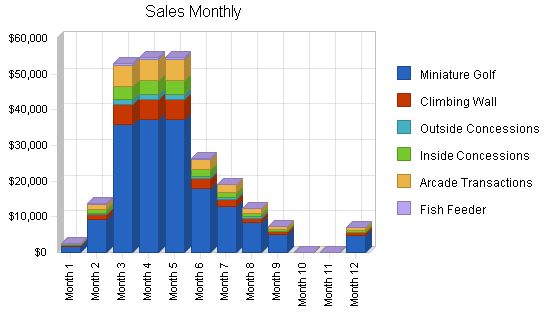
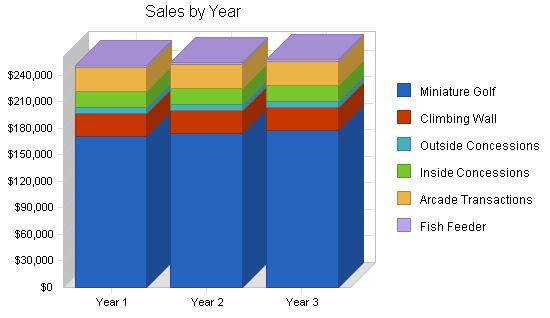
Sales Forecast
Year 1 Year 2 Year 3
Sales
Miniature Golf $170,760 $174,175 $177,659
Climbing Wall $25,614 $25,614 $25,614
Outside Concessions $6,831 $6,831 $6,831
Inside Concessions $17,930 $17,930 $17,930
Arcade Transactions $27,321 $27,321 $27,321
Fish Feeder $2,562 $2,562 $2,562
Total Sales $251,018 $254,433 $257,917
Direct Cost of Sales Year 1 Year 2 Year 3
Outside Concessions $1,707 $1,741 $1,776
Inside Concessions $6,275 $6,401 $6,529
Arcade Transactions $13,661 $13,661 $13,661
Fish Feeder $512 $522 $533
Subtotal Direct Cost of Sales $22,155 $22,325 $22,498
5.4 Milestones
The major milestones are separated into three categories:
1. The planning, or pre-construction phase
2. The construction phase
3. The operational phase
The business is the creation of John Putteer, solely responsible for oversight and coordination of the entire project.
The dollar figures used in the milestones table are approximate, based on current estimates and projections within the business plan.
Funding: Both commercial and private investors have expressed interest in reading the completed plan. They also believe in this proposal and have indicated an early positive interest in financing the project.
Construction: While John Putteer is the project coordinator, other contractors will be utilized during construction. The General Contractor will be Fairway Construction from Firefly, and the miniature golf course will be built by Mulligan-Bogey Leisure Builders.
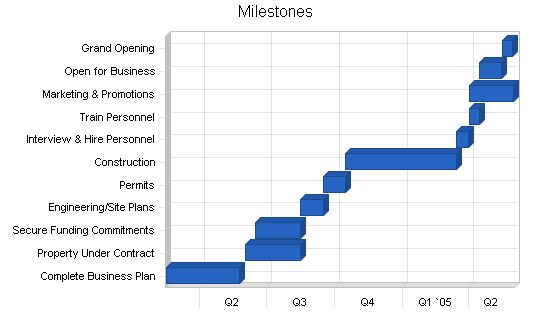
| Milestones | |||||
| Milestone | Start Date | End Date | Budget | Manager | Department |
| Complete Business Plan | 2/15/2004 | 5/24/2004 | $0 | Davis | Owner/Operator |
| Property Under Contract | 6/1/2004 | 8/15/2004 | $20,000 | Davis | Owner/Operator |
| Secure Funding Commitments | 6/15/2004 | 8/15/2004 | $0 | Davis | Owner/Operator |
| Engineering/Site Plans | 8/15/2004 | 9/15/2004 | $20,000 | Davis | Owner/Operator |
| Permits | 9/15/2004 | 10/15/2004 | $20,000 | Davis | Owner/Operator |
| Construction | 10/15/2004 | 3/15/2005 | $589,500 | Davis | Owner/Operator |
| Interview & Hire Personnel | 3/15/2005 | 3/31/2005 | $150 | Davis | Owner/Operator |
| Train Personnel | 4/1/2005 | 4/15/2005 | $350 | Davis | Owner/Operator |
| Marketing & Promotions | 4/1/2005 | 5/31/2005 | $2,400 | Davis | Owner/Operator |
| Open for Business | 4/15/2005 | 5/15/2005 | $500 | Davis | Owner/Operator |
| Grand Opening | 5/16/2005 | 5/29/2005 | $3,150 | Davis | Owner/Operator |
| Totals | $656,050 | ||||
Contents
Management Summary
John and Michelle both manage people in their current careers. John is an Engineer/Paramedic making split-second life and death decisions daily. He supervises another firefighter on the ambulance. For five years, John acted as a Captain for the Firefly Fire Department, supervising seven firefighters and making decisions for the city of Firefly. He was also President of the Firefly Firefighters Union for ten years. During this time, he made executive decisions and participated in negotiations. John is the owner/manager of Airport Mini Storage. When he bought the units, they were losing money at only 60% occupancy. Under his management, they consistently remain profitable at 90% occupancy.
Michelle is a dental hygienist who has one assistant. She also frequently manages student interns. As a dental hygienist, she is skilled in the management and motivation of each patient on a personal level. The ability to evaluate and judge acceptance and compliance in individuals is a skill she employs daily.
For additional information see Resumes below. [Confidential and Proprietary information omitted from this sample plan.]
6.1 Personnel Plan
Staffing
Optimum customer service is important, even critical, for the success of Sammy’s. But the owners also realize the high cost of employees. Fortunately, in the miniature golf industry, a high number of customers can be served efficiently by relatively few employees.
Sammy’s will require one staff member for off peak hours. Additional staff will be scheduled in accordance with demand determined by daily attendance patterns, eg: more staff will be required during summer months and during weekend and evening hours.
Manager
Sammy’s will have a salaried manager on staff during the months the facility is open.
Assistant Manager
The assistant manager will be an hourly employee working for $9.35 per hour.
Part-time Staff
Part-time staff will be used as needed for optimal customer service.
| Personnel Plan | |||
| Year 1 | Year 2 | Year 3 | |
| Manager | $25,000 | $25,625 | $26,266 |
| Asst. Manager | $15,000 | $15,375 | $15,759 |
| Part-time Staff (1.5 FTE) | $15,450 | $15,836 | $16,232 |
| Owners (1 FTE) | $0 | $0 | $0 |
| Total People | 5 | 5 | 5 |
| Total Payroll | $55,450 | $56,836 | $58,257 |
Financial Plan
The rapidly growing family entertainment industry is enjoying great success nationwide. These numbers are realistic, and conservative estimates have been used in all categories.
The lack of inventory and current liabilities may affect the "usual" business ratios for some readers.
7.1 Important Assumptions
Two types of businesses thrive in depressed economic times: alcohol and family entertainment. The family entertainment industry has performed well in prosperous times and economic downturns, even during the depression of the early 30s.
Sammy’s does not assume it has no competition. However, there is a distinct lack of family entertainment in the area. From our research, it is evident that new concept miniature golf courses are finding success in rural America, and locations near rural arterials are performing well across the nation. Locations in cities, such as St. Andrews and Mashie Woods, are also successful examples in our region.
Note the interest in current lending is high, which aligns with the conservative nature of this plan and demonstrates the basic health of this business concept.
| General Assumptions | |||
| Year 1 | Year 2 | Year 3 | |
| Plan Month | 1 | 2 | 3 |
| Current Interest Rate | 10.00% | 8.00% | 10.00% |
| Long-term Interest Rate | 8.00% | 8.00% | 8.00% |
| Tax Rate | 35.50% | 35.50% | 35.50% |
| Other | 0 | 0 | 0 |
7.2 Break-even Analysis
The Break-even table shows an extremely low variable cost. While some may consider this an error, it is actually the beauty of the business. The variable costs are limited to a scorecard (1 cent), a stubby pencil that is used several times, and the replacement of balls (which are used hundreds of times).
The percent utilization of the golf course during the season is the largest variable that determines the level of success in a miniature golf operation. Sammy’s has used conservative estimates of utilization (about 20%) in deriving projected revenues, despite having a population base of over 150,000 within a 15 mile radius. Even if the course utilization were only 10%, Sammy’s would still break even, providing a significant margin of error.
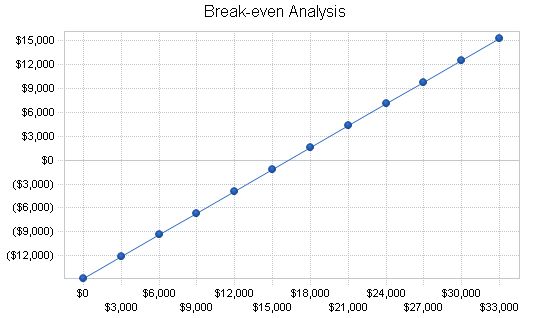
| Break-even Analysis | |
| Monthly Revenue Break-even | $16,279 |
| Assumptions: | |
| Average Percent Variable Cost | 9% |
| Estimated Monthly Fixed Cost | $14,842 |
7.3 Projected Cash Flow
Upon first reading, the projected cash flow numbers may appear unrealistic. It is important to reinforce the information conveyed in the notes to the sales forecast.
- The numbers have been verified by Mulligan-Bogey Leisure Builders. Mulligan-Bogey has built over 400 successful courses in the past decade and is well aware of the revenues generated by their courses.
- The revenue numbers were presented to two separate course owners who have opened courses within the last three years. The owners felt that the revenue estimates were conservative but accurate for planning purposes.
- Even if, for some unforeseen reason, the actual revenues were significantly lower, this business would still be profitable, with a positive cash balance from the first month.
Although the Cash Spending row in our projections only includes payroll expenses, we may choose to pay some bills (from the Bill Payments row) in fewer than 30 days once the business is operational; these would then also be part of cash spending. However, our current projections were designed conservatively.
The cost of the golf course includes everything except the scorecards. Therefore, no balls or clubs are included in the startup costs.
In addition to a $20,000 option, Sammy’s will offer a $1 lease for the first year. Although this may initially sound unacceptable, it is worth noting that the owner will receive $20,000 for the option, and the property has been vacant and for sale for two years without any offer.
Underwriters are working on an insurance quote. We have used the best estimate provided by insurance professionals.
The arcade will operate on a 50-50 split with an arcade company. We have shown the revenue as a sale and the arcade company’s share as an expense.
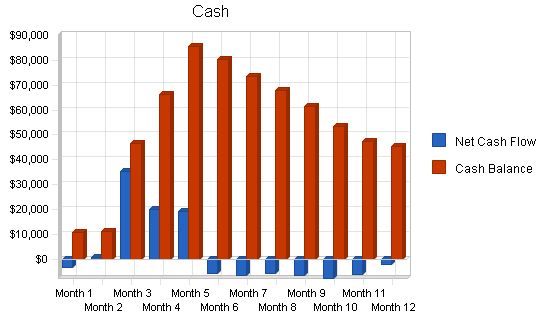
Pro Forma Cash Flow
| Pro Forma Cash Flow | |||
| Year 1 | Year 2 | Year 3 | |
| Cash Received | |||
| Cash from Operations | |||
| Cash Sales | $251,018 | $254,433 | $257,917 |
| Subtotal Cash from Operations | $251,018 | $254,433 | $257,917 |
| Additional Cash Received | |||
| Sales Tax, VAT, HST/GST Received | $0 | $0 | $0 |
| New Current Borrowing | $0 | $0 | $0 |
| New Other Liabilities (interest-free) | $0 | $0 | $0 |
| New Long-term Liabilities | $0 | $0 | $0 |
| Sales of Other Current Assets | $0 | $0 | $0 |
| Sales of Long-term Assets | $0 | $0 | $0 |
| New Investment Received | $0 | $0 | $0 |
| Subtotal Cash Received | $251,018 | $254,433 | $257,917 |
| Expenditures | Year 1 | Year 2 | Year 3 |
| Expenditures from Operations | |||
| Cash Spending | $55,450 | $56,836 | $58,257 |
| Bill Payments | $152,088 | $148,781 | $156,341 |
| Subtotal Spent on Operations | $207,538 | $205,617 | $214,599 |
| Additional Cash Spent | |||
| Sales Tax, VAT, HST/GST Paid Out | $0 | $0 | $0 |
| Principal Repayment of Current Borrowing | $0 | $0 | $0 |
| Other Liabilities Principal Repayment | $0 | $0 | $0 |
| Long-term Liabilities Principal Repayment | $11,837 | $12,819 | $13,883 |
| Purchase Other Current Assets | $0 | $0 | $0 |
| Purchase Long-term Assets | $0 | $0 | $0 |
| Dividends | $0 | $0 | $0 |
| Subtotal Cash Spent | $219,375 | $218,436 | $228,482 |
| Net Cash Flow | $31,643 | $35,997 | $29,435 |
| Cash Balance | $45,412 | $81,409 | $110,844 |
7.4 Projected Profit and Loss
Estimates for financial projections are prepared conservatively, with input and validation from three external sources. We are in contact with two course owners in similar demographic areas, one operating for one year and the other for four years. Their input has been invaluable in comparing projections with reality. Another excellent source is Mulligan-Bogey Leisure Builders, with over 400 successful courses built, providing realistic expectations for prospective owners.
Based on their past experience, all three sources agree that our sales projections are accurate or too low. They also agree that the expense projections are accurate or too high. This conservative forecast provides a safety buffer for both owner and investor.
Accounting and legal costs are projected at $1,250 initially for our Sub S Corporation, with an additional $500 for set-up by the accounting firm. The company will have quarterly book reviews, with accounting fees as listed below.
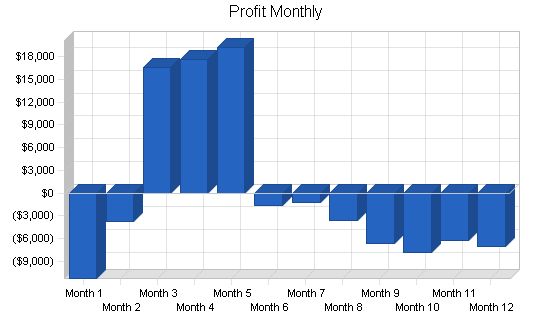
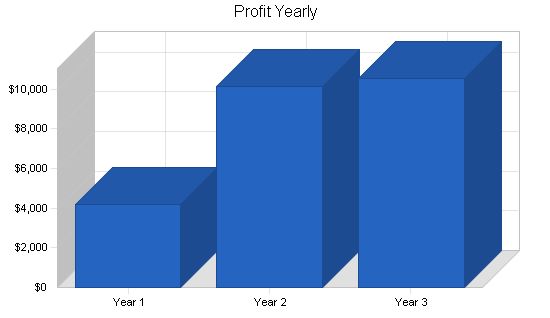
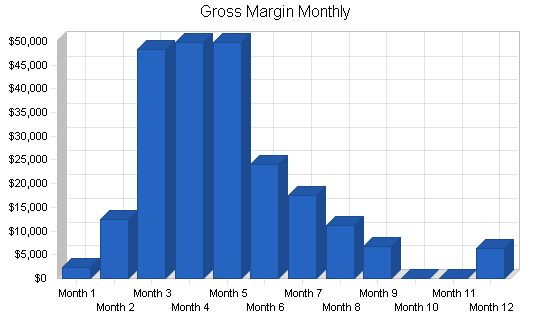
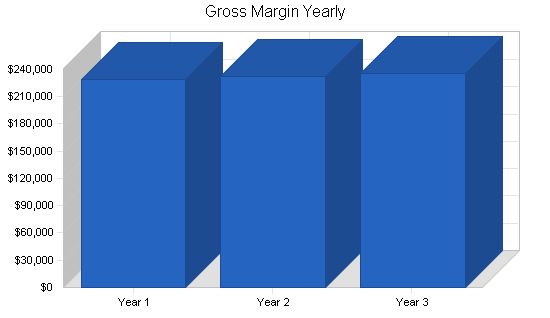
Pro Forma Profit and Loss
| Year 1 | Year 2 | Year 3 | |
| Sales | $251,018 | $254,433 | $257,917 |
| Direct Cost of Sales | $22,155 | $22,325 | $22,498 |
| Other Costs of Sales | $0 | $0 | $0 |
| Total Cost of Sales | $22,155 | $22,325 | $22,498 |
| Gross Margin | $228,863 | $232,108 | $235,419 |
| Gross Margin % | 91.17% | 91.23% | 91.28% |
| Expenses | |||
| Payroll | $55,450 | $56,836 | $58,257 |
| Sales and Marketing and Other Expenses | $9,250 | $6,150 | $6,335 |
| Depreciation | $32,640 | $32,640 | $32,640 |
| Land Lease | $33,000 | $33,000 | $33,000 |
| Utilities | $15,550 | $16,328 | $17,144 |
| Insurance | $10,000 | $10,500 | $11,025 |
| Payroll Taxes | $6,654 | $6,854 | $7,059 |
| Accounting & Legal | $2,750 | $2,833 | $2,917 |
| Operating Supplies | $2,510 | $2,585 | $2,663 |
| Telephone | $1,800 | $1,854 | $1,910 |
| Continuing Education | $8,500 | $3,500 | $3,850 |
| Total Operating Expenses | $178,104 | $173,079 | $176,800 |
| Profit Before Interest and Taxes | $50,759 | $59,029 | $58,619 |
| EBITDA | $83,399 | $91,669 | $91,259 |
| Interest Expense | $44,293 | $43,340 | $42,272 |
| Taxes Incurred | $2,295 | $5,569 | $5,803 |
| Net Profit | $4,170 | $10,119 | $10,543 |
| Net Profit/Sales | 1.66% | 3.98% | 4.09% |
7.5 Projected Balance Sheet
The asset side of the balance sheet shows an accurate picture.
The Balance Sheet shows the current liabilities at a zero balance. This is because all purchases and payroll are paid on a cash basis.
The beauty of this business is beginning to become apparent. There is a reasonably high capital output, but the operation of the business is completed with virtually no inventory to purchase and low labor cost. When the reader combines this information with the fact that the sales forecast is conservative, one can see that success is assured.
Pro Forma Balance Sheet
| Year 1 | Year 2 | Year 3 | |
| Current Assets | |||
| Cash | $45,412 | $81,409 | $110,844 |
| Other Current Assets | $23,230 | $23,230 | $23,230 |
| Total Current Assets | $68,642 | $104,639 | $134,074 |
| Long-term Assets | |||
| Long-term Assets | $649,500 | $649,500 | $649,500 |
| Accumulated Depreciation | $32,640 | $65,280 | $97,920 |
| Total Long-term Assets | $616,860 | $584,220 | $551,580 |
| Total Assets | $685,502 | $688,859 | $685,654 |
| Liabilities and Capital | |||
| Current Liabilities | |||
| Accounts Payable | $6,669 | $12,726 | $12,861 |
| Current Borrowing | $0 | $0 | $0 |
| Other Current Liabilities | $0 | $0 | $0 |
| Subtotal Current Liabilities | $6,669 | $12,726 | $12,861 |
| Long-term Liabilities | $548,163 | $535,344 | $521,461 |
| Total Liabilities | $554,833 | $548,071 | $534,323 |
| Paid-in Capital | $140,000 | $140,000 | $140,000 |
| Retained Earnings | ($13,501) | ($9,331) | $788 |
| Earnings | $4,170 | $10,119 | $10,543 |
| Total Capital | $130,669 | $140,788 | $151,332 |
| Total Liabilities and Capital | $685,502 | $688,859 | $685,654 |
| Net Worth | $130,669 | $140,788 | $151,332 |
7.6 Business Ratios
As noted earlier, this family entertainment business has no inventory and does not do sales on credit. Therefore several ratios normally deemed important by the reader will not show reasonable numbers. The high value for Profit Before Interest and Taxes is not an error.
The following table outlines some of the more important ratios from the Amusement and Recreation industry. The final column, Industry Profile, details specific ratios based on the industry as classified by the NAICS code 713990.
Ratio Analysis
| Year 1 | Year 2 | Year 3 | Industry Profile | |
| Sales Growth | 0.00% | 1.36% | 1.37% | 4.59% |
| Percent of Total Assets | ||||
| Other Current Assets | 3.39% | 3.37% | 3.39% | 41.52% |
| Total Current Assets | 10.01% | 15.19% | 19.55% | 51.30% |
| Long-term Assets | 89.99% | 84.81% | 80.45% | 48.70% |
| Total Assets | 100.00% | 100.00% | 100.00% | 100.00% |
| Current Liabilities | ||||
| Accounts Payable | 0.97% | 1.85% | 1.88% | 27.43% |
| Long-term Liabilities | 79.97% | 77.71% | 76.05% | 27.45% |
| Total Liabilities | 80.94% | 79.56% | 77.93% | 54.88% |
| Net Worth | 19.06% | 20.44% | 22.07% | 45.12% |
| Percent of Sales | ||||
| Sales | 100.00% | 100.00% | 100.00% | 100.00% |
| Gross Margin | 91.17% | 91.23% | 91.28% | 100.00% |
| Selling, General & Administrative Expenses | 1.11% | 0.73% | 0.74% | 63.25% |
| Advertising Expenses | 2.58% | 1.69% | 1.72% | 4.30% |
| Profit Before Interest and Taxes | 20.22% | 23.20% | 22.73% | 4.21% |
| Main Ratios | ||||
| Current | 10.29 | 8.22 | 10.42 | 1.04 |
| Quick | 10.29 | 8.22 | 10.42 | 0.60 |
| Total Debt to Total Assets | 80.94% |
| Pro Forma Profit and Loss | |||||||||||||
| Month 1 | Month 2 | Month 3 | Month 4 | Month 5 | Month 6 | Month 7 | Month 8 | Month 9 | Month 10 | Month 11 | Month 12 | ||
| Sales | $2,646 | $13,672 | $52,920 | $54,684 | $54,684 | $26,460 | $19,139 | $12,348 | $7,409 | $0 | $0 | $7,056 | |
| Direct Cost of Sales | $233 | $1,207 | $4,671 | $4,827 | $4,827 | $2,336 | $1,689 | $1,090 | $653 | $0 | $0 | $622 | |
| Other Costs of Sales | $0 | $0 | $0 | $0 | $0 | $0 | $0 | $0 | $0 | $0 | $0 | $0 | |
| Total Cost of Sales | $233 | $1,207 | $4,671 | $4,827 | $4,827 | $2,336 | $1,689 | $1,090 | $653 | $0 | $0 | $622 | |
| Gross Margin | $2,413 | $12,465 | $48,249 | $49,857 | $49,857 | $24,124 | $17,450 | $11,258 | $6,756 | $0 | $0 | $6,434 | |
| Gross Margin % | 91.19% | 91.17% | 91.17% | 91.17% | 91.17% | 91.17% | 91.18% | 91.17% | 91.19% | 0.00% | 0.00% | 91.18% | |
| Expenses | |||||||||||||
| Payroll | $4,700 | $5,500 | $7,000 | $7,000 | $7,000 | $5,500 | $5,000 | $4,750 | $4,500 | $0 | $0 | $4,500 | |
| Sales and Marketing and Other Expenses | $1,200 | $1,200 | $3,150 | $650 | $650 | $650 | $150 | $150 | $150 | $150 | $150 | $1,000 | |
| Depreciation | $2,720 | $2,720 | $2,720 | $2,720 | $2,720 | $2,720 | $2,720 | $2,720 | $2,720 | $2,720 | $2,720 | $2,720 | |
| Land Lease | $2,750 | $2,750 | $2,750 | $2,750 | $2,750 | $2,750 | $2,750 | $2,750 | $2,750 | $2,750 | $2,750 | $2,750 | |
| Utilities | $1,000 | $1,250 | $1,500 | $1,500 | $1,500 | $1,500 | $1,250 | $1,750 | $2,250 | $150 | $150 | $1,750 | |
| Insurance | $2,500 | $0 | $0 | Pro Forma Cash Flow | |||||||||
| Month 1 | Month 2 | Month 3 | Month 4 | Month 5 | Month 6 | Month 7 | Month 8 | Month 9 | Month 10 | Month 11 | Month 12 | ||
| Cash Received | |||||||||||||
| Cash from Operations | |||||||||||||
| Cash Sales | $2,646 | $13,672 | $52,920 | $54,684 | $54,684 | $26,460 | $19,139 | $12,348 | $7,409 | $0 | $0 | $7,056 | |
| Subtotal Cash from Operations | $2,646 | $13,672 | $52,920 | $54,684 | $54,684 | $26,460 | $19,139 | $12,348 | $7,409 | $0 | $0 | $7,056 | |
| Additional Cash Received | |||||||||||||
| Sales Tax, VAT, HST/GST Received | 0.00% | $0 | $0 | $0 | $0 | $0 | $0 | $0 | $0 | $0 | $0 | $0 | $0 |
| New Current Borrowing | $0 | $0 | $0 | $0 | $0 | $0 | $0 | $0 | $0 | $0 | $0 | $0 | |
| New Other Liabilities (interest-free) | $0 | $0 | $0 | $0 | $0 | $0 | $0 | $0 | $0 | $0 | $0 | $0 | |
| New Long-term Liabilities | $0 | $0 | $0 | $0 | $0 | $0 | $0 | $0 | $0 | $0 | $0 | $0 | |
| Sales of Other Current Assets | $0 | $0 | $0 | $0 | $0 | $0 | $0 | $0 | $0 | $0 | $0 | $0 | |
| Sales of Long-term Assets | $0 | $0 | $0 | $0 | $0 | $0 | $0 | $0 | $0 | $0 | $0 | $0 | |
| New Investment Received | $0 | $0 | $0 | $0 | $0 | $0 | $0 | $0 | $0 | $0 | $0 | $0 | |
| Subtotal Cash Received | $2,646 | $13,672 | $52,920 | $54,684 | $54,684 | $26,460 | $19,139 | $12,348 | $7,409 | $0 | $0 | $7,056 | |
| Expenditures | Month 1 | Month 2 | Month 3 | Month 4 | Month 5 | Month 6 | Month 7 | Month 8 | Month 9 | Month 10 | Month 11 | Month 12 | |
| Expenditures from Operations | |||||||||||||
| Cash Spending | $4,700 | $5,500 | $7,000 | $7,000 | $7,000 | $5,500 | $5,000 | $4,750 | $4,500 | $0 | $0 | $4,500 | |
| Bill Payments | $215 | $6,557 | $9,820 | $26,683 | $27,339 | $25,579 | $19,620 | $12,444 | $8,458 | $6,776 | $5,023 | $3,575 | |
| Subtotal Spent on Operations | $4,915 | $12,057 | $16,820 | $33,683 | $34,339 | $31,079 | $24,620 | $17,194 | $12,958 | $6,776 | $5,023 | $8,075 | |
| Additional Cash Spent | |||||||||||||
| Sales Tax, VAT, HST/GST Paid Out | $0 | $0 | $0 | $0 | $0 | $0 | $0 | $0 | $0 | $0 | $0 | $0 | |
| Principal Repayment of Current Borrowing | $0 | $0 | $0 | $0 | $0 | $0 | $0 | $0 | $0 | $0 | $0 | $0 | |
| Other Liabilities Principal Repayment | $0 | $0 | $0 | $0 | $0 | $0 | $0 | $0 | $0 | $0 | $0 | $0 | |
| Long-term Liabilities Principal Repayment | $951 | $957 | $963 | $970 | $976 | $983 | $989 | $996 | $1,003 | $1,009 | $1,016 | $1,023 | |
| Purchase Other Current Assets | $0 | $0 | $0 | $0 | $0 | $0 | $0 | $0 | $0 | $0 | $0 | $0 | |
| Purchase Long-term Assets | $0 | $0 | $0 | $0 | $0 | $0 | $0 | $0 | $0 | $0 | $0 | $0 | |
| Dividends | $0 | $0 | $0 | $0 | $0 | $0 | $0 | $0 | $0 | $0 | $0 | $0 | |
| Subtotal Cash Spent | $5,866 | $13,014 | $17,784 | $34,653 | $35,315 | $32,062 | $25,609 | $18,190 | $13,960 | $7,785 | $6 “> | ||
Hello!
I’m Andrew Brooks, a seasoned finance consultant from the USA and the mind behind phonenumber247.com.
My career is built on a foundation of helping individuals and businesses thrive financially in an ever-changing economic landscape. At phonenumber247.com, my aim is to demystify the complex world of finance, providing clear, actionable advice that can help you navigate your financial journey with confidence. Whether it’s personal finance management, investment strategies, or understanding the nuances of market dynamics, I’m here to share insights and tools that can propel you towards your financial goals.
Welcome to my digital space, where every piece of advice is a step closer to financial clarity and success!
